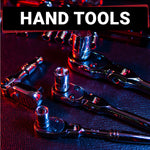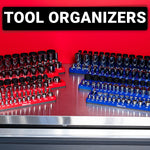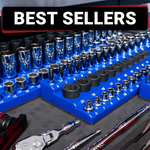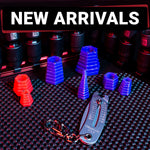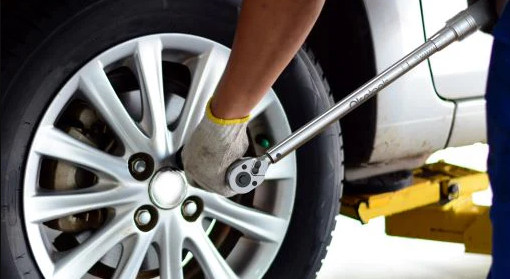The main difference between split beam and click torque wrenches is how they measure and indicate torque. Split beam wrenches use a visible beam that flexes to show torque, while click wrenches emit an audible click when reaching the set value.
Both provide reliable torque measurements, but they achieve this through distinct mechanisms that affect their use, maintenance, and durability.
We’ll tell you how split beam and click torque wrenches work, their advantages, and which situations suit each type best.
How Split Beam Torque Wrenches Work
Split beam torque wrenches measure torque using a calibrated flexing beam and a mechanical release mechanism. Unlike click-type wrenches, they do not rely on a compressed internal spring for torque measurement.
The wrench head consists of a primary beam that connects to the drive square and a pivoting arm that engages with the preset torque stop. As you apply force, the primary beam flexes, and once the target torque is reached, the pivoting arm disengages to signal that the correct torque has been applied.
Split beam wrenches operate with a preset torque setting. As you apply force, the internal mechanism holds tension until the target torque is reached. At that point, the wrench disengages to prevent over-tightening. Unlike single beam-type torque wrenches, split beam models do not provide a continuous torque readout.
How Click Torque Wrenches Work
Click torque wrenches measure torque using an internal spring-loaded cam mechanism. When you apply force to a fastener, the cam holds spring tension until the preset torque is reached. At that point, the mechanism moves and produces an audible "click" and a slight release of tension.
Inside the wrench, a cam-and-spring assembly connects to the drive head. You set your target torque by turning the handle, which preloads the spring to a specific tension. As you tighten a fastener, the cam mechanism holds the spring until the applied torque matches the preload.
The spring releases once you reach the target torque, producing a distinct click through the handle. This mechanical signal tells you to stop applying force.
The wrench contains precision-machined components, including a calibrated spring, a hardened cam, and a release mechanism that maintains accuracy. A micrometer-style scale on the handle displays the torque setting in Newton meters or foot-pounds.
Differences Between Split Beam and Click Type Wrenches
|
Split beam torque wrench |
Click type torque wrench |
|
|
Torque measurement |
Flexing beam with a preset mechanical release |
Internal spring-loaded cam mechanism |
|
Internal components |
Primary beam, pivoting arm, mechanical stop |
Spring, cam, detent mechanism |
|
Torque adjustment |
Preset dial or scale |
Rotating handle with micrometer-style scale |
|
Real-time readout |
No continuous readout |
No continuous readout |
|
Click or release |
Mechanical release when torque is reached |
Audible and tactile "click" when torque is reached |
|
Reset required |
No need to reset after use |
Must be reset to lowest reading after use |
|
Best use cases |
Repetitive applications, high-accuracy jobs |
General tightening tasks |
Accuracy and Calibration
Split beam and click torque wrenches provide precise torque application, but they differ in long-term accuracy and calibration needs.
Split beam torque wrenches maintain their accuracy for longer periods. Since they don’t rely on a compressed internal spring for torque measurement, there’s less risk of component fatigue over time. They’re less prone to calibration drift and require adjustments far less frequently than click style wrenches.
Click torque wrenches require regular calibration. The internal spring compresses and releases with each use, and over time, this repeated tensioning can affect accuracy. To maintain precision, manufacturers recommend recalibrating click wrenches at set intervals, often annually or after a certain number of cycles. If a click wrench is left at a high torque setting when stored, the spring can weaken which leads to incorrect torque readings.
While both wrenches provide accurate torque control when properly maintained, split beam wrenches are consistently accurate, while click wrenches require more frequent calibration.
Maintenance
Split beam and click torque wrenches require proper care to maintain accuracy and extend their lifespan. But their maintenance needs differ because of their internal mechanisms.
Split Beam Torque Wrench Maintenance
- Less frequent calibration: The flexing beam mechanism holds accuracy longer, so recalibration is needed less often.
- No need to reset after use: Unlike click wrenches, the torque setting can remain in place without affecting performance.
- Keep clean and dry: Dirt, debris, or moisture can interfere with the release mechanism. Wipe the tool after use and store it in a protective case.
Click Torque Wrench Maintenance
- Regular calibration: The internal spring mechanism weakens over time, so manufacturers recommend checking accuracy annually or after a certain number of cycles.
- Reset to the lowest setting after use: Leaving it set at a high torque value can cause the spring to lose tension and reduce accuracy.
- Store in a controlled environment: Avoid exposing the wrench to extreme heat, cold, or humidity, which can affect the spring's integrity.
- Check for smooth operation: If the wrench feels sticky or inconsistent, it may need lubrication or service to provide the cam and release mechanism function correctly.
Split beam wrenches need less maintenance, while click wrenches require more frequent calibration and careful storage to maintain accuracy. Regardless of type, regular inspections and proper handling will keep the tool functioning reliably.
Ease of Use
Click torque wrenches are simple to operate. The user sets the desired torque by rotating the handle to align with the micrometer-style scale. As the fastener tightens, the wrench produces a distinct "click" when it reaches the preset torque. This mechanical feedback signals the user to stop applying force to prevent over-tightening.
Split beam torque wrenches use a mechanical release when the target torque is met. The torque setting is adjusted using a built-in dial, which you can see on a scale. Since split beam wrenches do not need to be reset after use, they are more efficient for repetitive tasks. Users accustomed to the clear feedback of a click wrench may need time to adjust to the split beam’s operation.
For torque adjustments, the split beam style often has a more accessible mechanism, while the clicker type requires precise alignment on the scale. Those who prefer a distinct stop point may prefer a click wrench, while split beam wrenches suit users who want a tool that stays set for repeated applications.
Learn more on how to use torque wrenches!
Cost
The cost of split beam and click torque wrenches is based on torque range, build quality, and brand. Split beam wrenches generally have a higher upfront cost because of their durable construction and long-term accuracy.
- Split beam torque wrenches usually cost between $120 to $250.
- Click torque wrenches typically cost between $30 and $200, though high-capacity models can exceed this range.
While click torque wrenches are more affordable initially, they require more frequent calibration and careful maintenance.
Which Type Should You Choose?
The right torque wrench depends on your specific needs, how often you use it, and your preference for maintenance.
Choose a split beam torque wrench if:
- You need a tool that stays accurate for long periods with minimal calibration.
- You perform repetitive tasks where resetting the wrench after each use would slow you down.
- You prefer a durable, long-term investment with less frequent maintenance.
Choose a click torque wrench if:
- You want a more budget-friendly option.
- You prefer clear, audible feedback when reaching the target torque.
- You don’t mind resetting the torque setting after each use and performing regular calibration.
Click vs. Split Beam Torque Wrench FAQ
What type of torque wrench is most accurate?
A dial torque wrench is the most accurate, as it provides a direct torque measurement without relying on internal springs or release mechanisms. Split beam and click torque wrenches are also precise, but they require calibration over time, whereas dial wrenches maintain consistent accuracy with minimal drift.
Do split beam torque wrenches come with a calibration certificate?
Yes, many certified wrenches, including split beam models, come with a certificate of calibration to verify their accuracy rating.
Can I use a digital torque wrench instead of a split beam or click type?
A digital torque wrench provides an electronic readout and sometimes vibrates or beeps when reaching the set torque. While more advanced, a digital wrench requires batteries and may not be as durable as a split beam-type wrench for long-term professional applications.
What is a flex head torque wrench, and does it improve accuracy?
A flex-head torque wrench has an adjustable head that pivots so you can reach fasteners in tight spaces. While it boosts accessibility, it does not necessarily improve the accuracy rating of a wrench.
Are cheap torque wrenches reliable for major appliances?
Cheap torque wrenches may work for occasional use, such as assembling major appliances, but they often lack a calibration certificate and may require frequent recalibration. For precise work, investing in certified wrenches gives a more consistent performance.
Can a drive torque wrench be used for head bolts?
A drive torque wrench can tighten head bolts, but choosing the correct types of torque wrenches depends on the required torque range. Electronic torque wrenches or split beam-type models are often preferred for delicate automotive applications because of their accuracy and repeatability.
Should I store my torque wrench in a tool chest?
Keep your torque wrench in a tool chest to protect it from dust, moisture, and temperature fluctuations that could affect calibration. Always store it in a dry place and, for click wrenches, reset them to the lowest torque setting before storage.
Why is a torque wrench a must-have for professionals?
A powerful torque wrench brings precision, durability, and usability at once. Serious auto work needs tools that meet the requirements of professionals. Features such as a square-drive ratchet head, 72-tooth mechanism, and 15-degree swing arc provide a seamless, accurate operation. And durable Cr-V steel offers long-lasting corrosion resistance so your professional tools stand up to the test of time.
